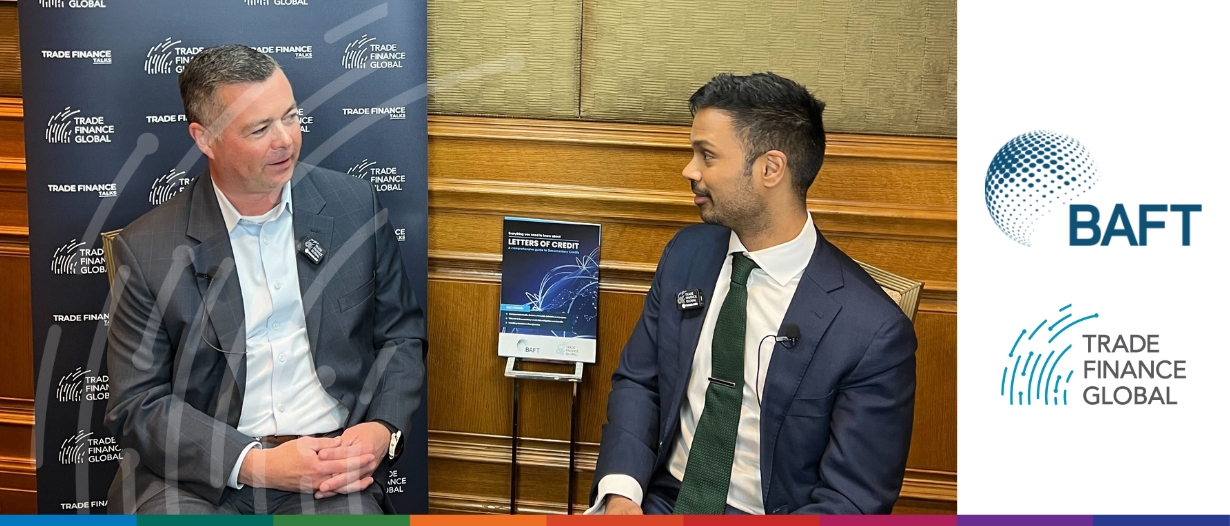Estimated reading time: 5 minutes
At BAFT’s 2024 International Trade and Payments Conference in Washington, D.C., TFG’s Deepesh Patel sat down with Keith Melton, Senior Vice President and RTP®Strategic Programme Manager, The Clearing House (TCH), to discuss the transformative impact and prospects of the RTP® network, recent regulatory updates, and the future of cross-border payments.
What is The Clearing House?
The Clearing House has operated within the United States private sector for a long time, over 171 years. In fact, the United States only had 31 states when TCH first began operations.
Now in 2024, TCH functions as a private sector payments operator, with networks for wire, automated clearing house (ACH), real-time payments, as well as cheque image clearing.
Melton said, “We’ve been in this business for a long time, and we’ve been driving collaboration and innovation in the space…we were actually the Fed before there was a Federal Reserve, and working with the financial institutions in times of crisis … and finding more efficient ways to clear cheques, and, more recently, really collaborating with the industry, the stakeholders, around real-time payments.”
The RTP network and industry collaboration
The RTP network is a retail real-time gross settlement system. The Clearing House launched this platform roughly six years ago, which helped usher in the era of instant payments in the US.
Melton said, “It’s transaction by transaction, clearing, settling, and having funds available instantly. It is unique in nature in that both sender and receiver can see confirmation that the transaction is complete and fund availability instantly. It’s irrevocable in nature. It’s a credit push system, and I think it’s important to note that it’s also based on a very data-rich messaging set based on ISO 20022.”
The creation and adoption of the RTP network is a significant step forward for the payments industry. It is this collaboration that enables the RTP to be such a successful system.
Naturally, TCH collaborates with other players within the wider payments ecosystem including banks, fintechs, and other vendors.
In recent months, The Clearing House has worked with financial institutions across the US. Melton said, “It’s truly a payments network available to everyone, both large institutions, smaller institutions, credit unions, and community banks. It is the largest real-time payments network in the country, both from a payments value and reach perspective.”
To date, The Clearing House has over 500 participants actively involved in their network. This accounts for roughly 67% of Demand and Deposit Accounts (DDA) across the country, and continues to grow each month.
In the fourth quarter of 2023, The Clearing House processed 74 million transactions on the RTP network, representing $39 billion in value. Melton said, “We’re growing at about 15% per quarter on the RTP network.”
This was only possible because The Clearing House worked with industry stakeholders, financial institutions, and several third-party service and technology providers to bring the brand-new payment rail to the market.
But the collaboration doesn’t stop there.
To stay up to date with the newest payment trends, The Clearing House also recently introduced a tokenisation solution to the market to be able to tokenise DDA for both the ACH network as well as the RTP network.
However, it is equally as important to not only continue to innovate, but to simply increase accessibility for all institutions. Considering this, TCH has worked with third-party providers to streamline access to the RTP network for small institutions, banks, and credit unions.
Challenges with changing regulations in the payments space
The regulatory landscape is constantly changing, an issue repeatedly reported at the BAFT International Trade and Payments Conference as one of the largest challenges faced by the industry.
With The Clearing House processing over $2 trillion in transactions per day, Melton said, “Our primary focus is really working with our members, our owners, our financial institutions that are part of those networks. Making sure they’re secure, they’re reliable, and they’re resilient, is our primary focus.”
In this regard, The Clearing House watches regulation changes very closely. Specifically, they have been monitoring developments in open banking, data privacy, and what the Consumer Financial Protection Bureau (CFPB) does concerning Section 1033 of the Dodd-Frank Act on Consumer Access to Financial Records.
But regulation isn’t the only industry development that needs attention.
The CHIPS® network is a high-value payments network offered by The Clearing House. It is the largest private sector U.S. dollar clearing and settlement system in the world, providing fast and final payments and the most efficient liquidity savings mechanism available today.
Melton said, “The Clearing House is driving the implementation of ISO 20022 for CHIPS…working with all of our participants on the network.” It is targeting the conversion to go live in early April of this year. According the Melton, the development has progressed smoothly, and the implementation is expected to proceed on schedule.
Industry progression with the G20’s roadmap for cross-border payments
The G20 roadmap for cross-border payments was recently published. Objectives include decreasing costs and fees to 1-3%, increasing speed for 75% of transactions so that they are available within one hour, and for 100% of users to have access to at least one form of payment, as well as increasing transparency.
Currently, the RTP network is domestic only, but already meets many of the requirements set out by the G20 roadmap. The RTP network prices transactions at four and a half cents per transaction for sending, with any insured bank or credit union receiving it for free. All of the payments are settled within seconds, beating the G20 Roadmap objectives.
To help stay competitive in cross-border transactions, The Clearing House completed a proof of concept for US Dollar-Euro transactions.
























